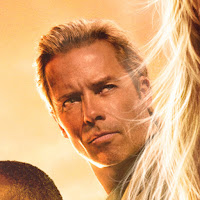A multi-model text is a form of media that has two or more ways of creating meaning through different ways of communication. This can be through written text on screen, spoken language, sound effects and music.
TITLE OF FILM: Catch Me If You Can (2002, Directed by Steven Spielberg)
| ||
FEATURES OF MULTIMODAL TEXT
|
DESCRIPTION OF FEATURE IN TRAILER
|
ANALYSIS OF IMPACT ON AUDIENCE
|
Written text on screen
|
When introducing the actor's names and when it says 'based on a true story' the text is transitioned into the trailer by two arrows running parallel to each other moving across the screen in opposite directions.
Other on-screen text includes: 'Frank never went to flight school' (proceeded by a shot of Frank mas a pilot) Frank never went to medical school' (Proceeded by a shot of Frank as a doctor) 'Frank never went to law school' (Proceeded by a shot of Frank as a lawyer) 'Because Frank is still in high school' |
The fact that this says 'based on a true story' would intrigue the audience as this might intrigue them to find out how the protagonist, Frank, managed to get away with becoming a pilot, lawyer and doctor without any training or how he never gets caught by the FBI, or at least avoided them for as long as possible. Considering the film's title and the the plot of the film, the arrows help to connote the fact that Frank is avoiding the authorities while they are trying to catch him for being a con artist.
This would intrigue the audience as they would know that you would need further education in order to get into these professions yet the on-screen text tells them that Frank has not attended any of these and that he is still in high school. This will make the audience ask a simple question of 'How did he do it?'. |
Spoken language
|
Carl: 'You're gonna get caught, its like Vegas, the house always wins'
[Carl and Frank speaking over the phone] Carl: 'What do you want' Frank: 'To apologise' Carl: 'You didn't call to apologise did you? You have no one else to call' |
This line of dialogue could be a hint of foreshadowing to the audience. Car id comparing the FBI as a house and therefore frank should be an 'outsider'. This metaphor Carl uses compares the FBI's mission to capture Frank as a casino game, as if it was a gamble, that both sides are risking everything they have in order to get the job done. This could make the audience support Frank even more because they would know that he would literally lose everything if he does not escape the FBI.
This piece of dialogue achieves the same effect as the previous, as the audience will feel more sympatheic towards Frank, as Carl implies that Frank is alone and has no one to trust. |
Moving images
|
As this film is based off of a true story there are no special effects featured in the trailer and the cinematography is not overly dramatic in order to help retain the realism in the narrative. As mentioned before, we see many scenes showing different sides to Frank's life, hinting to the audience that he will go through a series of events where he has a rise in power over the FBI, and a fall where the FBI are catching onto his case. There are two consecutive shots that show Frank (now with long hair) and a young girl as they look at each other through a window (shown in the bottom left image). This could possibly symbolise that through innocent eyes that do not look at him as a criminal, Frank is not such of a bad person that higher authorities make him out to be.
| |
Sound effects
|
There is not a great amount of sound effects in this trailer since most of the sound in the trailer is the background song.
When we see Frank as a lawyer, he says 'This is irrefutable evidence that the defendant is lying' and proceeds to slam his open case down to close in which we hear a loud 'thud' with a short echo. |
Like I have mentioned before, they likely did not put in too many sound effects in order to make the film more realistic and not far-fetched as this is based off of a true story.
The music playing from the start of the trailer up to this point stops as soon as we hear this 'thud', creating a dramatic pause, signifying to the audience that Frank is very confident in his statement. It also helps build up apprehension for the following on-screen text that tells teh audience that Frank is still in high school, making this revelation have even more of an impact. |
Music
|
The music being played in the background of the trailer is called 'Don't Rain On My Parade' by Bobby Darin.
| The lyrics of the song can relate to the protagonist's life. 'Don't tell me not to fly I've simply got to If someone takes a spill It's me and not you Don't bring around a cloud To rain on my parade.' Considering how the protagonist, Frank cons people by pretending to be a pilot, a lawyer and a doctor, and gets a wealthy living out of it,and how the FBI are after him to bring an end to his law-breaking ways. The lyrics 'Don't tell me not to fly' strongly relates to the fact that he posed as a pilot for a a number of years. The title of the song itself makes it seem as if it is Frank directly telling the FBI not to 'rain on his parade'. |




















